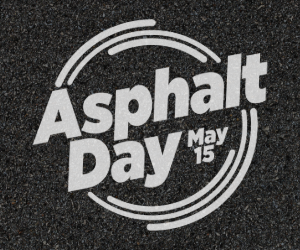Asphalt pellets are a different delivery system for liquid polymer asphalt and can be used in a variety of paving operations. Instead of being a liquid, the pellets come in a portable, solid form.
They are the size of split peas, and are a combination of asphalt and modifiers, additives and fillers. They can be transported and stored in small bags, “Super Sacks” or in bulk.
The pellets are designed to mix with heated aggregate, for either conventional hot mix or warm mix paving, or for applications requiring mix production at the paving job site, such as pothole and utility cut patching.
Pellets can be useful in transporting asphalt binder to remote locations or to incorporate the use of special additives. They can be used to reduce high-energy consumption, reduce binder/additive segregation, pave at remote locations, expedite production schedules, incorporate waste materials and sometimes increase worker safety.
Alternative delivery system
Asphalt pellets are manufactured at a central processing facility and then transported to the asphalt plant or job site at ambient temperature. Then the proper proportion of pellets is added into the mixing chamber of the asphalt plant.
“One manufacturing process of asphalt pellets can be likened to making Hershey kisses,” says Dave Johnson, Asphalt Institute Regional Engineer. “The pellets travel down a rolling conveyor or belt with a metered nozzle. They are squeezed into a pellet on the conveyor belt, then they cool off and dry.”
Many types of polymers, fibers, fillers, anti-strip chemicals and waste materials such as ground tire rubber (GTR) and recycled asphalt shingles (RAS) can be incorporated, as long as the appropriate processing equipment is available.
Pellet formulation
Unlike conventional liquid asphalt, heated storage is not necessary, so liquid anti-strip amines or other desired additives with heat stability considerations can be incorporated. Because physical separation is not a problem when delivering modifiers in pellet form, the binder formulated can include materials that could not be considered when transporting modified liquid asphalt.
Crumb rubber produced from scrap tires as well as other polymers can be sheared into the binder, or waste shingles can be premixed with rejuvenating chemicals to restore binder properties before manufacturing the pellet. Once the binder meets specifications, mineral fillers, fibers or other solid components can be added to the pelletized mix.
Pellets can be formulated with the exact concentrations of asphalt binder and additives to produce hot mix asphalt, or can be proportioned to blend with additional asphalt during the manufacture of the hot mix. If the pellet remains tacky, a non-stick coating is applied to prevent agglomeration during storage and handling.
Transportation and storage
Liquid asphalt is normally transported in heated tanker trucks, rail cars or barges. The shipping distances depend upon the ability to maintain heat so the material can be pumped properly.
Asphalt pellets, however, are transported in bulk or in other forms, such as one-ton “Super Sacks.” They can be transported and stored at ambient air temperatures. Unlike conventional neat or modified asphalts, pellets do not need to be heated before use. Consequently, they open opportunities for more modes of transportation, as well as for shipping long distances.
Storing the pellets at low temperatures prevents any degradation of the product by overheating, which can occur when heating liquid asphalt in storage tanks.
Johnson says that storing asphalt pellets without heat is a big advantage. “The dry pellets can be infused into a drum or batch plant when you are ready to use them,” he says. “In the meantime, you don’t need to heat them as you would liquid asphalt or liquid additives.
“For example,” says Johnson, “you can stockpile asphalt pellets—even enough for a 100,000 ton project and have them ready when you are. Just pave a pad and pile the pellets on the pad away from the sun.”
Mixing with aggregates
Asphalt pellets can be readily mixed with heated aggregate in conventional hot mix paving plants. Many asphalt plants use a percentage of Reclaimed Asphalt Pavement (RAP). Pellets can be added through the RAP collar on a drum plant, weighed into the mixing chamber for a batch plant or blown into the mixing chamber. If pellets are formulated with modifiers, additional asphalt can be added to the aggregate using the normal liquid spray system.
Whatever method is used, the pellets preclude the need for special equipment and processes usually required for the addition of fibers, chemical anti-strip additives, crumb rubber, recycled polymers, hydrated lime, latex polymers, warm-mix additives or other modifiers.
Remote locations
One of the advantages of asphalt pellets is the ease of transporting the materials at ambient temperatures. Unlike traditional asphalt products, they don’t need heating and are shipped as a solid rather than a liquid. Further, there is no danger of contamination in liquid transport vehicles or tanks that have not been completely emptied of their previous cargo.
“Using pellets, we can do remote projects that would otherwise be too expensive or difficult,” says Kelly Sockwell, Technical Director for Phoenix Industries. “For example, we are looking at an airfield on an island where we can barge in the material, then use it whenever the paver is ready.”
Also, contractors in cold climates can carry on patching and paving throughout the winter when local HMA plants are closed for several months.
Repairs, utility cuts and small paving projects
Municipalities that do their own work or contractors that specialize in utility cut repairs, pothole patching, golf cart paths or small residential projects can use the pellets on-site, producing the mix as needed. “Pellet pothole patch can be used around the U.S. in various climates,” says Sockwell. “We have found it has been successful in New Jersey, New York and other northeastern states.”
Sockwell adds that the key to successful pothole and utility cut patching is using modified asphalt pellets. The modified pellet patch is much more durable than “throw and go” or other interim pothole patching, he says. “It is a permanent patch that lasts for several years, often outlasting the surrounding pavement.”
Paving contractors don’t have to depend on asphalt producers who favor high production rates and large projects. Using pellets eliminates wasting the asphalt mix at the end of the day because the mix is too cold to use. Heating and mixing on site guarantees the correct amount of mix is used. Most importantly, the mix design, binder grade and additives can be selected to meet the needs for each specific project.
Green paving technologies
Asphalt pellets also promote green paving technologies, such as warm mix and recycling.
Warm mix additives can be incorporated in the pellets, as well as crumb rubber, recycled polyethylene, and reclaimed asphalt shingles.
For small producers, the pellets can be used to produce mixes using up to 100 percent RAP in place of virgin aggregates. The cost savings can be significant if RAP from a utility cut is crushed and remixed on-site.
While asphalt pellets won’t take over the majority of asphalt moved around the country, they are a very useful alternative to traditional liquid asphalt moved by truck and barge.














